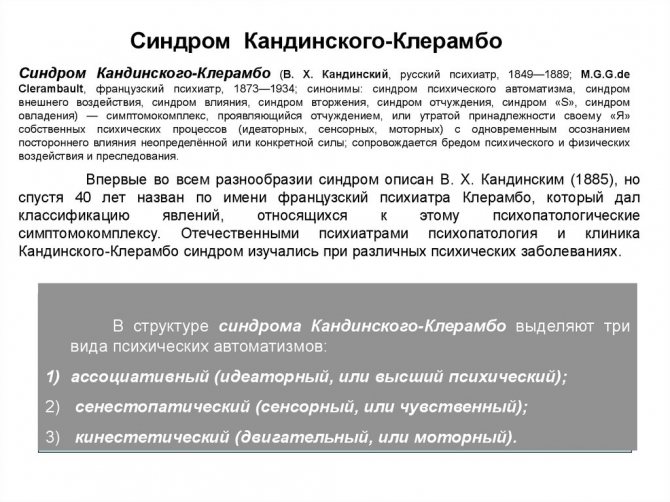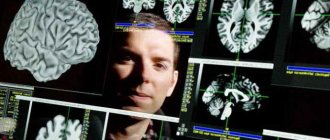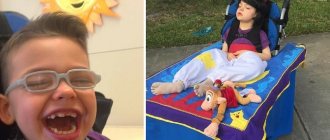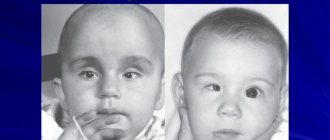Development mechanism
The syndrome of mental automatism develops as follows.
- Due to the wide amplitude of the so-called mood swings, the patient is confident that his emotions are controlled from the outside. At this stage, it is important to treat with sedatives and regularly visit a psychotherapist. At the initial stages, affective disorders are observed.
- depressive despondency gives way to exalted inspiration;
- anger, voluptuousness or fear are too exaggerated and feigned;
- a state of rapturous ecstasy or emotional devastation.
- At the next stage, symptoms are represented by pathological sensory, associative and motor self-perceptions. The patient suffers from an obsession that his movements, feelings and thoughts are influenced by unknown things. If at this stage the patient withdraws into himself and begins to fearfully hide his own subordination to someone or something from the outside, the third stage begins.
- The third stage of development of the syndrome is characterized by the inability to control any imaginary influence.
- with motor automatism, a person unexpectedly causes pain to himself, makes sudden movements, grabs his hair or shouts out words;
- with senestopathic syndrome, delirium of physical influence is observed in the form of a state of suffocation, irresistible trembling from the cold, piercing with electric current and a feeling of constriction of one or another organ (brain, stomach, etc.);
- sensory automatism provokes distortion of color, light, taste perception and a feeling of pain. This subtype is characterized by pseudohallucinations of lack of hearing, vision, or being inside a rainbow.
What is excluded when diagnosing schizophrenia and why?
It is impossible to say which psychopathological syndrome does not occur in schizophrenia. Differentiation in diagnosis is carried out differently. Excludes:
- the occurrence of psychosis due to drug overdose;
- the presence of somatic diseases that can cause organic psychosis; psychotic schizophrenia-like state;
- neurosyphilis;
- bipolar affective disorder;
- major depressive disorder;
- borderline state;
- schizoaffective disorder.
But all mental syndromes are excluded simply in order to make a different diagnosis and develop an adequate treatment regimen. In paranoid schizophrenia, the patient may experience a depressive episode. This in itself does not mean that his paranoid schizophrenia suddenly took over and disappeared. On the other hand, mistaking major depressive disorder for schizophrenia can have bad consequences. MDD requires the prescription of antidepressants, and schizophrenia requires antipsychotics, which will not help at all and will harm people with other types of disorders.
Worth seeing: Autism and schizophrenia
A person with this syndrome feels the influence of force on the brain from the outside, sees hallucinations
What is Kandinsky-Clerambault syndrome?
Kandinsky-Clerambault syndrome (Mental automatism syndrome, alienation syndrome, impact syndrome) is a complex mental disorder that is characterized by acute obsessive states.
The patient believes that his thoughts and body are subject to outside influence. Many people lose control over themselves and find themselves in a helpless position when it is impossible to carry out even familiar, everyday tasks on their own.
What to do with this syndrome? How to help a patient get rid of an illness?
Mental automatism syndrome is a type of paranoid-hallucinatory disorder. The syndrome itself can be divided into several subtypes:
- motor or kinesthetic automatism;
- associative or ideational automatism;
- sensory automatism.
Motor automatism is a disorder associated with kinesthetic sensations and perception. Main symptoms: stiff, awkward movements, intermittent speech, unnatural gestures and facial expressions.
It seems to the patient that his body is controlled by someone from the outside, that his movements, even blinking his eyes, occur not of his own free will, but due to someone else’s influence. Many people's gait changes and their speech becomes slurred.
Situations arise when a person can utter unpleasant words, ultimately justifying it by the fact that such words were not uttered of his will.
Associative automatism or ideation syndrome is a disorder that is associated with mental and thinking abilities. The symptoms in this case relate entirely to the patient’s mind. It seems to him that his thoughts are accessible to others, they are watching them, someone is trying to steal his ideas, eavesdropping on his internal dialogues.
note
Many people cease to be responsible for their mood and actions, justifying this by the fact that all mental and mental functions have been assigned to themselves by another person who controls them.
Some experience an acute obsessive state, in which it seems that someone from the outside is imposing other people’s thoughts and ideas on the patient.
Sensory automaticity is a disorder that is often accompanied by pseudohallucinations. Patients experience causeless and obsessive painful sensations that they cannot describe or specify their location.
Be healthy!
Kandinsky-Clerambault syndrome is a psychopathological complex of symptoms, including pseudohallucinations, mental automatisms, delusional ideas about influence and persecution. Psychotic manifestations are made in nature. It seems to patients that their thoughts are accessible to others and changed, emotions and actions are controlled from the outside, involuntary. For diagnosis, psychiatrists use clinical procedures - collection of anamnestic data, clinical conversation, observation. Treatment is mainly medicinal: antipsychotics, antidepressants, and sedatives are prescribed.
General information
Kandinsky-Clerambault syndrome is named after the researchers who described its manifestations in detail. V. Kandinsky studied automatisms during his lifetime, but his works were published posthumously in 1890. G. Clerambault summarized the available information and identified three types of automatisms (1927). Other names for the disorder are mental automatism syndrome, alienation and impact syndrome. The prevalence is highest among patients with schizophrenia, ranging from 50-60%. In the general population this figure is less than 1%.
Causes
Kandinsky-Clerambault syndrome is characteristic of schizophrenia. This disease should be considered as the main cause. Symptoms of mental automatisms can appear in the pre-manifest period; their complication occurs as endogenous pathology develops. It is noted that patients with a pronounced emotional component – fear, anxiety, depression – are at increased risk. Rare causes of the syndrome can be:
- Organic psychoses. Automatisms are possible with epilepsy, traumatic brain injuries, brain tumors, and cerebrovascular accidents. They usually appear in the acute period.
- Severe intoxication. Hallucinatory-delusional symptoms occur in case of poisoning with alcohol, psychostimulants (amphetamines, cocaine). Frequent and prolonged intoxication become provoking factors for the onset of schizophrenia and the active development of Kandinsky-Clerambault syndrome.
- Infectious diseases. Psychoses caused by infection can occur with automatisms, delusions and hallucinations. Productive symptoms fade away if the patient recovers.
Pathogenesis
Kandinsky-Clerambault syndrome develops on the basis of a psychotic disorder. The first pathogenetic theory, proposed by Clerambault, describes mental automatism as a result of deautomatization of mental activity: the natural course of cognitive functions and emotions is disrupted, and pathological reflexivity is added. The consequence of this is a feeling of alienation from one’s own thoughts, feelings, and actions.
In recent decades, A. Mehrabyan’s theory has been actively revived. It is based on the assumption that mental automatisms and depersonalization arise when the gnostic feeling is disrupted. It is a complex complex of emotional and intellectual components of cognition. With alienation syndrome, a splitting of mental and feeling processes occurs.
Classification
There are several types of classification of Kandinsky-Clerambault syndrome. According to the characteristics of the clinical picture, the following are distinguished:
- classic version - the patient feels as if his actions and thoughts are controlled by someone else;
- introverted version - the patient believes that he is able to influence others, change their mood, feelings and actions. Often such a disorder is accompanied by ideas of grandeur and paraphrenia.
Another classification defines the syndrome of delusional and hallucinatory type. If the delusional type develops, then delusions and automatisms dominate, and hallucinations are extremely rare or absent. The hallucinatory type is characterized by a predominance of pseudohallucinations, weak severity of delusional symptoms and automatisms. According to the nature of the course, the syndrome is classified into two types:
- Chronic. Clinical signs remain invisible for a long time and gradually intensify. Years pass from the onset of the syndrome to its diagnosis. Detection of the disorder occurs after the accumulation and complication of automatisms. The delirium is systematized, aimed at specific people and situations. The experiences of patients have a fantastic content (the impact of aliens, intelligence agents).
- Spicy. Symptoms increase very quickly, the disorder proceeds in paroxysms, accompanied by vivid, figurative, poorly systematized delirium. Emotions are bright, from fear and suspicion to high spirits. Automatisms are pronounced. Depending on the clinical manifestations of psychosis, the acute syndrome may be included in paranoid, sensory or interpretive delusions.
Symptoms
Mental automatisms
The key link of the syndrome is mental automatisms. These phenomena represent a pathological feeling of “doneness,” “imposition,” “suggestion” of thoughts, emotions and actions. Patients are convinced that they are affected by various types of energy: rays, waves, “the power of consciousness.” According to the content, automatisms are ideational, sensory and senestopathic.
Ideatorial (associative) automatism is a consequence of an imaginary influence on intelligence, memory, attention and other cognitive processes. The simplest option is mentalism. This is a feeling of involuntary flow of ideas, ideas, memories. Another example is the symptom of openness. It is expressed by the feeling that everyone around him knows about the content of the patient’s thoughts and discusses them in secret from him.
Associative automatisms also include the rustling of thoughts - unintelligible noise due to the movement of ideas in the head; the sound of thoughts - the internal sound of words and sentences that the patient is thinking about; thought taking away - the disappearance of all ideas and memories due to the deliberate efforts of another person. Other symptoms are thoughts and dreams made by others, deliberate blurring of memories, externally created emotions.
Senestopathic (sensory) automatism is a painful, uncomfortable sensation that develops as a consequence of imaginary extraneous forces. It manifests itself as a feeling of cold, heat, pain in the body and internal organs. With a long course of the syndrome, senestopathy becomes pretentious and unusual. Patients report sensations of pulsation, squeezing, twisting and expansion.
Kinesthetic (motor) automatisms - the conviction that the movements of patients are made by them against their will, under external influence. Patients believe that someone is taking away their ability to act voluntarily: an invisible force moves their limbs, creates a feeling of numbness and paralysis, and forces them to say certain words (move their tongue). Automatisms, as a rule, develop in a certain sequence: first ideational, then senestopathic, followed by kinesthetic ones.
Pseudohallucinations
In addition to automatisms, Kandinsky-Clerambault syndrome is manifested by pseudohallucinations of various modalities. Patients distinguish them from objects of reality, since all images have the character of an imposition, something made. Common visual images are faces, panoramas, supposedly shown to patients using special equipment. Auditory hallucinations are represented by noises, words, phrases that are transmitted to the patient via radio or other equipment. They can be neutral or imperative.
Complications
With an unfavorable course of schizophrenia, Kandinsky-Clerambault syndrome progresses rapidly. Automatisms become more complex, appear frequently, and lead to the development of depersonalization - a severe disorder of self-perception with alienation of the patient’s personality. The sense of one’s own “I” is lost, the ability to control one’s own thoughts, emotions, and actions.
When the delusional component predominates, delusional depersonalization is formed - the conviction that changes have occurred in the patient’s being, as a result of which he has turned into something else. Patients imagine themselves as recruited agents, shadows of other people. Depersonalization is difficult to treat, is regarded as a sign of an unfavorable course of schizophrenia, and quickly leads to a mental defect.
Diagnostics
In most cases, Kandinsky-Clerambault syndrome is detected in patients with a confirmed diagnosis of schizophrenia. Rarely does it precede the onset of the disease, manifesting itself as single mental automatisms, or develops on the basis of an organic, infectious or intoxicating lesion of the central nervous system.
The examination of patients is carried out by a psychiatrist; in order to determine the causes of the syndrome, the help of a neurologist, infectious diseases specialist, or functional diagnostics doctor may be required. There are no special diagnostic procedures for identifying automatism syndrome. The psychiatrist uses clinical methods:
- Anamnesis collection. Often the person being examined has a diagnosis of schizophrenia or a hereditary history of this disease, severe infections, intoxication, brain tumors, or head injuries. The provoking factor can be severe stress, acute poisoning with alcohol, narcotic substances.
- Conversation. During communication with patients, the doctor notes characteristic changes in speech and thinking: inconsistency and illogicality of judgment, delusional, including paranoid, ideas. Typically, patients openly talk about automatisms and hallucinations, but the plot of delusions can prevent this (for example, if the doctor is assessed as one of those who influences the patient’s psyche).
- Observation. With a detailed clinical picture of the syndrome, inappropriateness is often noted in behavior: excessive alertness or agitation, attempts to escape from the doctor’s office, looking at empty walls (hallucinatory images). Emotions are unstable and do not correspond to the situation. Fear, tension, and aggressiveness often predominate.
Treatment
Therapy is carried out comprehensively. The main activities are carried out in the hospital, additional and supportive measures are carried out at home. They are focused on relieving acute symptoms and, if possible, eliminating the cause of automatisms. Most often, patients are prescribed procedures to treat schizophrenia or reduce its manifestations:
- Drug therapy. To reduce psychotic productive symptoms (delusions, hallucinations) and relieve psychomotor agitation, antipsychotics are prescribed. Antidepressants, tranquilizers, and sedatives can help stabilize the emotional background and restore normal sleep.
- Biological therapy. In some forms of schizophrenia, in the initial stages of the disease, it is possible to use insulin comatose or electroconvulsive therapy. These methods give good results, but have many side effects, so they are carried out only with the voluntary consent of the patient.
- Psychotherapy. At the stage of recovery or remission, psychotherapeutic assistance is introduced. It helps the patient cope with feelings of confusion, anxiety, and depression. Effective are techniques aimed at restoring personal structures - the formation of values, attitudes, and life goals.
Prognosis and prevention
Kandinsky-Clerambault syndrome may have a favorable prognosis if treatment is started in the early stages. For advanced hallucinatory-delusional phenomena, intensive treatment helps reduce the severity of symptoms and achieve remission.
Prevention consists of regular medical supervision of patients with schizophrenia. People at risk for developing this mental illness require periodic, at least once a year, examinations by a psychiatrist. It is also worth excluding all factors that provoke psychosis - drug use, alcohol abuse, severe stress.
Treatment methods
The key to success in the treatment of external influence or alienation syndrome is an integrated approach, involving psychotherapeutic and medicinal interventions with subsequent monitoring and a rehabilitation period.
- Drug treatment with psychotropic medications is primarily prescribed to achieve emotional stability. Most often, experts give preference to such modern antipsychotics as Triftazin and Haloperidol in combination with antidepressants and antipsychotics.
- A little later, it is important to prescribe psychotherapy if the medications give a positive result and the patient is more conscious of the processes that are happening to him.
- The rehabilitation period, in turn, involves the following measures.
- physical therapy classes;
- following a diet without legumes, nuts, chocolate and other copper-rich foods;
- attending group psychotherapy sessions in addition to ongoing individual ones.
Each case requires an individual approach to provide the most effective treatment. The attending physician develops a general strategy only after a complete examination of the patient and analysis of his behavior.

Preventive measures require appropriate and necessarily timely treatment of the underlying mental illness that may accompany the syndrome in question.









